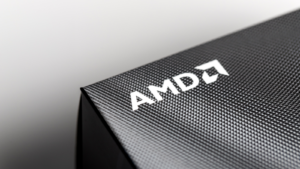That metric is calculated by subtracting the cost of sales from total sales. What remains is the gross margin, which is then divided by total sales. The higher it is, the better. It reflects pricing power overall.
Gross margin percentage is a valuable metric because it indicates a business’s overall strength. If you can price high over the long term, you succeed. Let’s look at tech stocks with competitive advantages that exhibit this.
Nvidia (NVDA)

Anyone who follows the stock market knows that Nvidia (NASDAQ:NVDA) has a massive competitive advantage in AI chips.
That has manifested as high sales prices that lead to incredible gross margins. Nvidia’s H100 chips sell for roughly $30,000 each. However, that is at bulk prices in companies such as Meta Platforms, which can negotiate prices down as they buy in such high volumes. Reports show individuals paying more than $40,000 for Nvidia’s H100 chips.
Nvidia’s upcoming Blackwell chips will likely cost nearly $40,000 apiece. This means that Nvidia enjoys incredible pricing advantages that lead to high gross margins. Those gross margins can be found here. What’s particularly important is that the company has historically been able to produce high-margin goods within the semiconductor industry.
The company has a current competitive advantage in that its AI chips are simply the most powerful. However, Nvidia has historically enjoyed high gross margins, meaning it can identify chips to produce, for example, that consistently lead to high margins in gaming. In other words, Nvidia appears to be more than a flash-in-the-pan success.
Broadcom (AVGO)

Broadcom (NASDAQ:AVGO) is a designer and supplier of semiconductors that remain in high demand throughout the tech sector. Importantly, it is also a tech stock that exhibits strong competitive advantages.
Before getting into those competitive advantages, I should note that Broadcom is undertaking a stock split that benefits share prices. The company follows Nvidia’s lead after seeing it succeed in its stock split. Broadcom shares have been priced above $1,000 throughout 2024, making it an obvious target for a split.
That stock split will be enacted on July 15th and should increase demand by making shares more accessible at much lower prices.
Back to the point: Broadcom exhibits a massive competitive advantage as measured by gross margin percentages. It is only slightly behind Nvidia by that measure. Gross margin percentages at Broadcom are currently high relative to historical values. That’s a clear reflection of AI pricing at the moment. However, it should also be noted that Broadcom’s historical margins remain well above levels that indicate long-term competitive advantage.
Advanced Micro Devices (AMD)

Advanced Micro Devices (NASDAQ:AMD) continues to benefit from the attention the second best AI chip producer deserves. Investors know the story by now: AMD plays second fiddle to Nvidia in terms of AI chips. Those chips are slightly less powerful than Nvidia’s but much cheaper overall.
Thus, AMD’s AI opportunity remains strong due to its value offering. Enterprises, data centers and other firms that demand chips don’t necessarily need the absolute height of computing power. That’s where AMD shines.
The company continues to do very well in gross margins. Those gross margin percentages are currently in the neighborhood of 46% and have hovered around 40% over the past ten years. That’s an important figure because it is generally accepted that gross margin percentages above 40% indicate long-term competitive advantage.
AI is AMD’s most recent opportunity, leading to a strong competitive advantage. However, the company has also proven to have a long-term competitive advantage dating back to its recent roots as a graphics processor powerhouse. AMD makes chips that satisfy industry needs, whatever those may be at the moment. The company, like Nvidia, is highly capable of producing chips that satisfy overarching demand trends across the industry.
Apple (AAPL)

Apple (NASDAQ:AAPL) stock is surging at the moment, bringing its market capitalization above the $3 trillion mark once again. That has made it the world’s most valuable company, reclaiming the title from Microsoft. It’s a back-and-forth battle that is sure to continue as the tech giants battle for AI dominance.
A host of catalysts are responsible for the recent resurgence, and this article discusses them in detail. The most important of these is AI enhancements coming to the latest iPhone models. Those enhancements are expected to drive demand and spike sales by causing owners of older models to update.
That’s a very good sign for Apple overall, as iPhone sales have continued flagging recently. It’s reasonable to anticipate that Apple is beginning a new super cycle of iPhone sales as a result.
It also promises to raise the company’s gross margin percentages even higher than they are currently. Apple’s dominance stems primarily from the popularity of its iPhones. Demand for iPhones should spike again, making now a good time to buy Apple.
Microsoft (MSFT)

Microsoft (NASDAQ:MSFT) is unsurprisingly a stock with massive competitive advantages. It’s tough to find a reason to avoid Microsoft. Some would argue that it’s overpriced, but I don’t think it is. I will use the company’s competitive advantage as the primary basis of my argument here. Still, I’d also like to note that traditional valuation metrics suggest it isn’t as overpriced as some believe.
Microsoft is such a strong investment from the gross margin percentage perspective because that metric has minimal variance overall. Historical trends show that Microsoft consistently produces gross margins in the 60 to 70% range. Not only are those ranges exceptionally high, but they’re also tightly bound. That suggests dominance with minimal risk.
It’s challenging to argue Microsoft’s strength in that regard. However, many will say that Microsoft is overpriced. I don’t believe that’s the case, at least not by P/E ratio. Microsoft P/E ratios are currently higher than their ten-year median but nowhere near all-time highs. Microsoft has room to climb higher as its AI investment could push margins even higher well into the foreseeable future.
Meta Platforms (META)

Meta Platforms (NASDAQ:META) is an interesting stock whose performance is measured by gross margin percentage. Although it is historically quite strong, it is lower than other competitors within the interactive media industry.
The explanation for those relatively low margin percentages is easily explainable. Meta Platforms also produces and manufactures hardware, most recently for its Reality Labs division. Hardware manufacturing requires substantial labor, which shows up in the cost of sales line on the income statement. In other words, Meta Platforms have higher fees than other interactive media firms that are less manufacturing intensive.
Meta Platforms is again very strong, which is indicative of a resurgent economy overall.
The company lives and dies by advertising revenues, which were particularly strong in the fourth quarter and a general indicator of an uptick in overall economic activity.
Those ads have very high margins and Meta Platforms dominates that space through Facebook. That isn’t going to change soon.
Palantir Technologies (PLTR)

Palantir Technologies (NYSE:PLTR) continues to emerge as one of the better stock opportunities overall. The company continues to prove its doubters wrong, reaching profitability much quicker than anticipated.
Palantir has built and operated multiple intelligence platforms that strongly leverage AI, becoming one of the best enterprise AI companies in the process. However, the point that I want to make overall relates to its competitive advantage, again, as measured by gross margin percentages. The company is relatively young yet is already approaching the top 10% of competitors within its sector by that measure.
In short, Palantir appears to be building a company with a durable competitive advantage.
Palantir has historically been known as a company that is highly aligned with the public sector and the defense industry in particular. However, commercial revenue growth is outpacing the company’s public sector growth, which is the primary reason for believing it will carve out a significant place in the enterprise AI space.
On the date of publication, Alex Sirois did not have (either directly or indirectly) any positions in the securities mentioned in this article. The opinions expressed in this article are those of the writer, subject to the InvestorPlace.com Publishing Guidelines.
Alex Sirois is a freelance contributor to InvestorPlace whose personal stock investing style is focused on long-term, buy-and-hold, wealth-building stock picks. Having worked in several industries from e-commerce to translation to education and utilizing his MBA from George Washington University, he brings a diverse set of skills through which he filters his writing.
